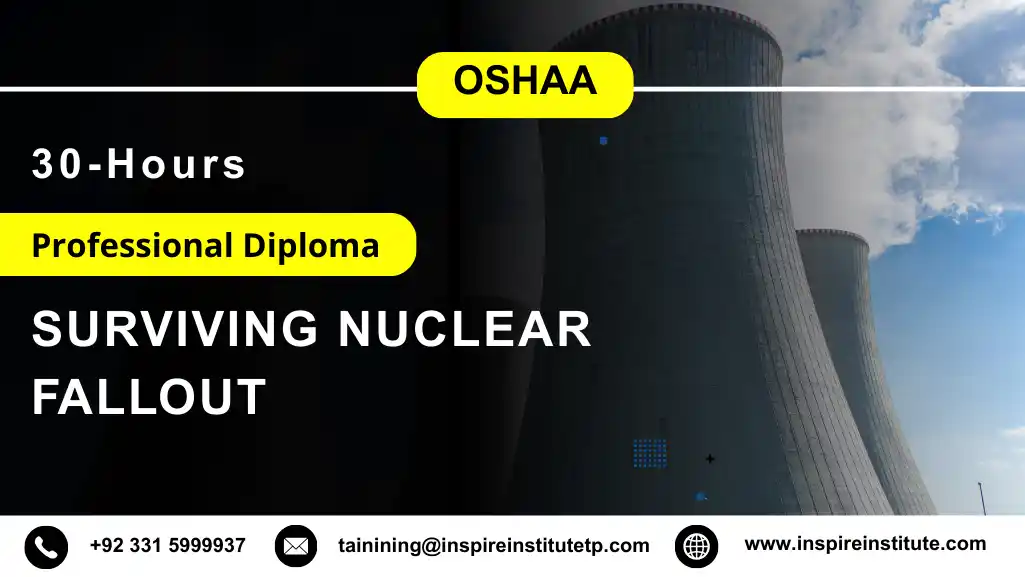OSHAA 30-Hours Professional Diploma in Surviving Nuclear Fallout
The OSHAA 30-Hours Professional Diploma in Surviving Nuclear Fallout is an internationally recognized program designed to provide learners with critical knowledge and practical skills to survive and respond effectively in the event of a nuclear fallout. This course combines theoretical understanding with actionable strategies, equipping individuals, emergency responders, and safety professionals with the tools necessary to protect themselves and others during a nuclear crisis.
The curriculum covers essential topics such as understanding nuclear threats, fallout patterns, radiation exposure risks, emergency preparedness, shelter design, food and water safety, first aid, decontamination procedures, and long-term survival strategies. Learners will gain insights into both individual and community-level response plans, ensuring they can act decisively and safely in high-risk scenarios.
This diploma is ideal for emergency management personnel, disaster response teams, safety officers, civil defense volunteers, military personnel, survival enthusiasts, and anyone interested in gaining comprehensive knowledge of nuclear fallout survival techniques. It is also suitable for educators and community leaders who aim to train or guide others in emergency preparedness.
Completing the OSHAA 30-Hours Professional Diploma in Surviving Nuclear Fallout empowers learners with internationally recognized expertise, enhancing their ability to plan, prepare, and respond to nuclear emergencies effectively. The qualification provides practical skills, promotes resilience, and strengthens preparedness, making it an essential credential for personal safety, professional development, and community protection in today’s high-risk world.
Why Choose this Qualification
The OSHAA 30-Hours Professional Diploma in Surviving Nuclear Fallout is an internationally recognized program designed to provide learners with practical knowledge and skills to survive and respond effectively in nuclear fallout situations. Choosing this qualification ensures participants gain both theoretical understanding and actionable strategies for emergency preparedness and crisis management.
- Gain comprehensive knowledge of nuclear threats, fallout patterns, and radiation exposure risks.
- Learn practical survival strategies for immediate and long-term safety during nuclear fallout events.
- Develop emergency preparedness skills, including shelter design, food and water safety, and first aid.
- Understand decontamination procedures and radiation protection techniques to reduce health risks.
- Enhance career opportunities in emergency management, civil defense, military services, disaster response, and safety consultancy.
- Achieve an internationally recognized qualification, boosting credibility and professional value globally.
- Learn to plan and execute community and personal response strategies, ensuring safety in high-risk scenarios.
- Acquire practical tools for risk assessment, decision-making, and crisis management under extreme conditions.
- Benefit from a flexible 30-hour program, allowing learners to study at their own pace while balancing professional or personal commitments.
- Build a foundation for advanced studies in disaster management, emergency response, and survival training, opening pathways for further specialization and career growth.
This diploma equips learners with practical skills and international recognition, empowering them to survive nuclear fallout events, support others, and enhance safety and preparedness in personal, professional, and community contexts.
Course Overview
UK based Qualification
Study Units: 10 Units
Evidence & Assignment Based
Mandatory Units
Who Should Take This Course
The OSHAA 30-Hours Professional Diploma in Surviving Nuclear Fallout is designed for a wide audience seeking practical skills and knowledge to respond effectively during nuclear fallout scenarios. This course is ideal for professionals, emergency responders, enthusiasts, and anyone interested in enhancing personal and community safety in high-risk situations.
- Emergency Management Personnel including civil defense officers, disaster response teams, and safety coordinators who need comprehensive knowledge of nuclear fallout survival strategies.
- Military and Security Personnel seeking to enhance operational preparedness and safety protocols during nuclear incidents.
- Safety Officers and Risk Managers in industries, organizations, and governmental bodies responsible for emergency planning and crisis management.
- Survival Enthusiasts and Preparedness Trainers interested in advanced strategies for personal and family safety during extreme situations.
- Healthcare Professionals and First Responders who may need to provide care and support in post-nuclear fallout scenarios.
- Educators and Community Leaders aiming to train others in emergency preparedness and nuclear fallout survival techniques.
- Students and Researchers studying disaster management, emergency response, safety engineering, or civil defense.
- Individuals Focused on Personal and Family Safety seeking to gain knowledge and practical skills for surviving nuclear fallout events.
This diploma provides learners with internationally recognized knowledge and practical skills, empowering them to plan, respond, and survive nuclear fallout events effectively, while promoting preparedness and resilience across personal, professional, and community settings.
Course Benefits
The OSHAA 30-Hours Professional Diploma in Surviving Nuclear Fallout equips learners with essential skills and knowledge to respond effectively during nuclear emergencies. Completing this diploma provides practical expertise, enhances professional credibility, and improves personal and community safety.
- Gain comprehensive understanding of nuclear threats, fallout patterns, and radiation risks for informed decision-making.
- Learn practical survival strategies for both immediate and long-term protection in nuclear fallout scenarios.
- Develop emergency preparedness skills, including shelter construction, food and water safety, first aid, and evacuation planning.
- Understand decontamination procedures, radiation protection, and health risk mitigation to reduce exposure and enhance safety.
- Enhance career opportunities in emergency management, civil defense, military services, disaster response, and safety consultancy.
- Achieve an internationally recognized qualification, boosting professional credibility and employability globally.
- Acquire skills to plan, implement, and lead community and personal response strategies during nuclear emergencies.
- Learn risk assessment, decision-making, and crisis management techniques applicable under extreme conditions.
- Benefit from a flexible 30-hour program, allowing learners to study at their own pace while balancing personal or professional commitments.
- Build a foundation for advanced studies in disaster management, survival training, or emergency response, opening pathways for further specialization and career growth.
This diploma ensures learners gain practical, actionable skills and globally recognized expertise, empowering them to survive nuclear fallout events, safeguard others, and promote resilience in personal, professional, and community contexts.
Eligibility Criteria
The OSHAA 30-Hours Professional Diploma in Surviving Nuclear Fallout is designed to be accessible to learners from diverse backgrounds while ensuring participants are prepared to gain maximum benefit from the course.
Age Requirement
Learners must be at least 16 years old, with no upper age limit, allowing participants of all ages to enroll.
Educational Background
No formal qualifications are required, making the course suitable for beginners, students, professionals, and survival enthusiasts.
Working Experience
Prior experience in emergency management, disaster response, or safety planning is not mandatory, though it may help learners relate theory to practical scenarios.
Language Proficiency
Basic English literacy is required as all study materials, assignments, and assessments are delivered in English. International learners may need to demonstrate proficiency through IELTS 3.5–4.0 or an equivalent.
The Qualification Process
The OSHAA 30-Hours Professional Diploma in Surviving Nuclear Fallout follows a structured, internationally recognized process, ensuring learners gain both theoretical knowledge and practical skills for effective survival and emergency response.
- Step 1: Enrollment
Learners register through authorized OSHAA training providers, providing basic personal details and confirming they meet entry requirements. The enrollment process is simple and accessible. - Step 2: Access to Study Materials
Participants receive comprehensive resources covering nuclear threats, fallout patterns, radiation exposure, emergency preparedness, shelter design, first aid, decontamination, and survival strategies. - Step 3: Guided Learning
The program consists of 30 guided learning hours, allowing learners to study at their own pace. It combines theoretical knowledge with practical, scenario-based exercises. - Step 4: Assessments and Evaluations
Learners complete written assignments, case studies, and practical exercises to demonstrate understanding of nuclear fallout survival, risk assessment, crisis management, and emergency response techniques. - Step 5: Ongoing Support
Qualified trainers provide guidance throughout the course, assisting learners with assignments, practical exercises, and applying survival strategies in simulated or real-world scenarios. - Step 6: Completion & Certification
Upon successful completion, learners are awarded the OSHAA 30-Hours Professional Diploma in Surviving Nuclear Fallout, an internationally recognized qualification that enhances career opportunities, professional credibility, and practical preparedness.
This structured qualification process ensures learners gain practical skills, confidence, and global recognition, empowering them to survive nuclear fallout events and contribute to personal, professional, and community safety.







